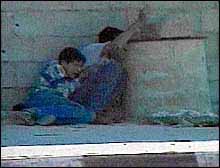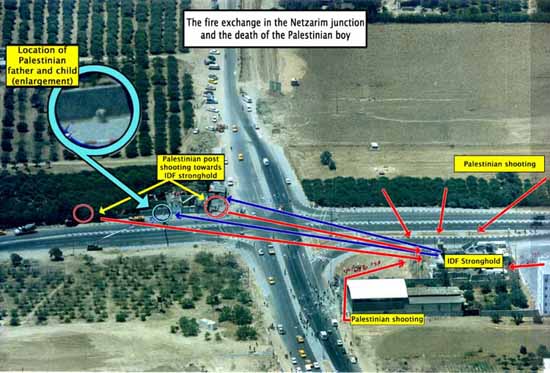Al-Aqsa Intifada: The Mohammed al-Dura Case
Perhaps the most vivid image of the Al-Aqsa Intifada is the film of a Palestinian father supposedly shielding his son from Israeli gunfire while caught in a crossfire between the IDF and Palestinian terrorists at a major junction in the Gaza Strip.
 Still-frame image from France2 video showing al-Dura and his father behind a wall during the shooting |
On September 30, 2000, a number of Palestinians - including policemen - attacked an IDF outpost at the Netzarim junction using Molotov cocktails and automatic weapons. The soldiers returned fire toward the sources of the shooting. During the exchanges of fire, a Palestinian child - Mohammed al-Dura, aged 12 - was apparently hit by gunfire and killed.
Immediately following the incident, the France 2 TV station released footage from the scene that seemed to show the boy being killed during the course of the fighting. The images of the boy cowering behind his father were broadcast around the world and Israel was universally blamed for al-Dura's death.
At first, the IDF accepted responsibility for the boy's death. Subsequent investigations, however, have revealed that this story was far more complicated than the video supposedly showed and that the boy, if killed at all, was most likely hit by Palestinian bullets and not IDF fire.
Following an internal IDF investigation of the incident released in November 2000 which found that al-Dura was likely killed by a Palestinian policeman and not IDF fire, Israel retracted its original claim of culpability for the childs death. The investigation noted that its results were not conclusive, but Maj.-Gen. Yomtov Samia noted that "the possibility that [al-Dura and his father] were shot by Palestinians is higher than that they were shot by Israelis."
Maj. Gen Samia added that the conclusions of the investigation were based on an in-depth analysis of all information the IDF could gather about the incident; however, he added that a number of questions about the incident remained, including why al-Dura and his father Jamal, 37, of the El-Bureij refugee camp, had even come to the intersection when the fighting there had already lasted several hours.
 |
The IDF report was confirmed during an investigation by German ARD Television, which said the footage of al-Dura's death was censored by the Palestinians to look as if he had been killed by Israeli fire when, in fact, his death was caused by Palestinian gunfire.
The IDF and German investigations relied heavily on the evidence broadcast by France 2. Contrary to the conventional belief that the footage of the incident was broadcast live, it was actually edited before it was aired on TV. A number of cameramen were in the area filimg the incident, however, only one - Talal Abu Rahma, a Palestinian freelancer working for France 2 - recorded the shooting.
In 2004, French Jewish media commentator Philippe Karsenty suggested that France 2 actually cut out the final few seconds of the original footage, during which Mohammed appeared to have lifted his hands and move his legs, proving that he was not actually killed. Karsenty also accused the stations of fabricating the entire incident, staging the scene with Palestinian protesters with the goal of slandering Israel and presenting the Palestinians as victims. France 2 sued Karsenty for libel and won when a French court ruled that the footage had not been staged. However, in September 2007, another French court instructed the TV channel to hand over the entire footage and in the full video, al-Dura can in fact be seen waving his hand, moving his leg and without any visible bloodstains.
Adding to the skepticism about the source of the deadly fire, Yehuda David, the Israeli doctor who operated on Mohammed's father Jamal after he was injured in the crossfire, reported that Jamal's injuries - which Jamal told the media were incurred during the fighting - could not have come from IDF fire and were actually the result of an earlier attack by Hamas operatives who suspected Jamal of collaborating with Israel.
Moreover, in 2003, journalist James Fallows revisted the case and found that "the physical evidence of the shooting was in all ways inconsistent with shots coming from the IDF outpost." Fallows cited a number of unanswered questions, which have led some to conclude the whole incident was staged.
For example, Fallows asked, "Why is there no footage of the boy after he was shot? Why does he appear to move in his father's lap, and to clasp a hand over his eyes after he is supposedly dead? Why is one Palestinian policeman wearing a Secret Service-style earpiece in one ear? Why is another Palestinian man shown waving his arms and yelling at others, as if 'directing' a dramatic scene? Why does the funeral appear — based on the length of shadows — to have occurred before the apparent time of the shooting? Why is there no blood on the father's shirt just after they are shot? Why did a voice that seems to be that of the France 2 cameraman yell, in Arabic, 'The boy is dead' before he had been hit? Why do ambulances appear instantly for seemingly everyone else and not for al-Dura?"
In 2006, Karsenty was convicted of libel, a judgment that was overturned on appeal in 2008.
In 2009, Denis Jeambar, editor-in-chief of the French news weekly l’Express, and filmmaker Daniel Leconte, a producer and owner of the film company Doc en Stock, saw the raw, unedited video of the shooting and said the boy could not have been shot by Israeli soldiers. “The only ones who could hit the child were the Palestinians from their position. If they had been Israeli bullets, they would be very strange bullets because they would have needed to go around the corner.”
In May 2013, an Israeli special governmental inquiry committee formed in 2012 submitted its final report on the incident to Prime Minister Benjamin Netanyahu. According to the findings of the committee, there was no evidence that the boy or his father were injured at the time the video was shot, and therefore there is reasonable doubt regarding the IDF's responsibility for the boy's death. The committee also noted that France 2 framed the story as if at the time of its broadcast there was concrete evidence supporting the claim that the boy had died as a result of IDF gunfire, despite the fact that the responsibility for al-Dura's death was still in dispute, thus putting the entire credibility of the news report into question.
Yuval Steinitz, who chaired the inquiry committee, commented on the report saying, "This was a blood-libel against Israel. The French report was simply false."
In June 2013, a Paris court convicted Karsenty of defamation for accusing France 2 channel of staging the Al-Dura video. The court fined him 7,000 euroes (the equivalent of 33,000 NIS or 9100 USD).
Sources: The Atlantic (June 2003); CNN; CNS News (February 15, 2005); Commentary (September 2005; May 19, 2013); Haaretz (May 19, 2013); IDF Spokesperson; Jerusalem Post (November 28, 2000); JTA (March 21, 2002; February 15, 2012); Ynet News (February 19, 2012; May 20, 2013); Times of Israel (June 26, 2013).


